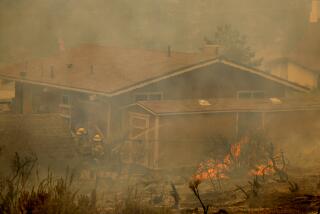Fighting Fire Danger Before the Flames Begin : Surrounding homes with the right plants in the right places can help prevent losses in the event of a blaze.
At this time of year--and for the rest of the year--there will probably be a wildfire burning somewhere in California. Frequently, our county is involved. Despite the constant threat of fire, people who live in at-risk areas seldom think about doing anything to protect their houses--until it’s too late.
The most effective defense, according to the Ventura County Fire Protection District, has less to do with hoses and fire extinguishers than with the way people have landscaped their property.
“We have built our homes on the most flammable place on Earth,” observed Owen Dell, a Santa Barbara landscape designer who is a pioneer in the emerging profession of “firescaping,” the fire department-recommended practice of clearing away the brush within 30 to 100 feet of your house and replacing it with fire-resistant, low-lying plants.
“Firefighters are extremely good at what they do, but they can only do so much,” Dell said. “If you’ve put in the wrong kind of landscaping, they can’t help you.”
This “defensible space,” as firefighters call it, can improve the odds your house won’t catch fire if there’s a conflagration in your neighborhood. The California state fire marshal and local fire officials can’t agree on these odds--but the range is 50% to 90% in your favor.
“It doesn’t have to mean your house looks like a bunker in a cleared field,” Dell said. “It’s not so much the species of plants but their arrangement. High trees overhanging the roof, close-in bushes and badly maintained growth are the most dangerous.”
One client, Venturan Joanna Ho, decided to commission a fire retardant landscape design for her property after a neighbor installed one.
“It looked good. We had let our hillside go (without maintenance) and we wanted to prevent a fire hazard,” Ho said. Her neighbor referred her to the Santa Barbara Botanic Garden, which told her about Dell.
The folks at the garden also recommended a visit to the Firescape Demonstration Garden nearby at Santa Barbara Fire Station No. 7. It’s the only such public demonstration in Southern California.
When Earthwatch took a tour guided by Dell, who designed the spread, a Simi Valley family was also there.
“It’s neat!” enthused Mark Killian, who knows he lives in a fire-hazard zone and wanted to know what to do to protect his house.
Lists of fire-retardant plants, which emphasize those that are drought-tolerant and native to California, and plans for arranging the plants are free to the public.
The demonstration gets high praise from other landscaping professionals. Thousand Oaks landscape architect John K. Innis calls it “absolutely the best” example of fire-retardant landscaping “and it’s also a very nice garden--which it has to be or people would just say ‘phooey’ to the whole idea.”
What you see there is dwarf coyote bush, Algerian ivy, rockrose, ice plant, creeping daisies, toyon, laurel, pepper trees and oleander. Dell has a photo collection of houses impacted by wildfire--one in particular appears quite clearly to have been spared because of oleander planted nearby.
Here in Ventura County, the fire departments serving the county and the cities of Ventura and Oxnard will provide planting recommendations and a Homeowner’s Landscape Fire Safety Checklist. Local nurseries, particularly Katsuda Nursery and Green Thumb, stock many of these species.
Details
* FYI: For free advice on fire-retardant landscaping, call Ventura City Fire Department, Kathy Taylor-Gauthier, at 654-7790; Ventura County Fire Protection District, Sandy Wells, 389-9710, or the Somis office of the U.S. Department of Agriculture Soil Conservation District, Sheri Kittich, 386-4489. Also visit the Firescape Demonstration Gardens at Santa Barbara Fire Station No. 7, 564-5702. For professional firescape design services, call Owen Dell, 962-3253.
More to Read
Sign up for Essential California
The most important California stories and recommendations in your inbox every morning.
You may occasionally receive promotional content from the Los Angeles Times.










